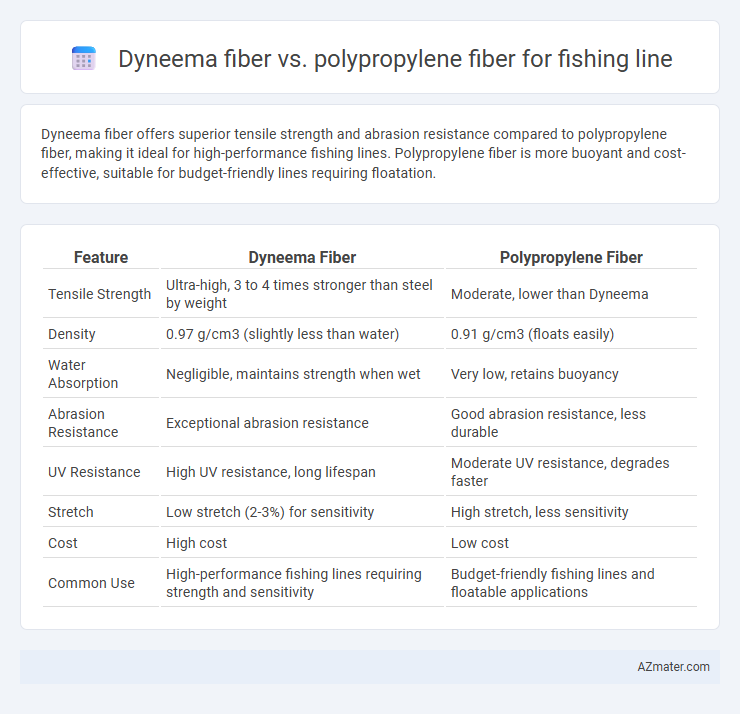Dyneema fiber offers superior tensile strength and abrasion resistance compared to polypropylene fiber, making it ideal for high-performance fishing lines. Polypropylene fiber is more buoyant and cost-effective, suitable for budget-friendly lines requiring floatation.
Table of Comparison
| Feature | Dyneema Fiber | Polypropylene Fiber |
|---|---|---|
| Tensile Strength | Ultra-high, 3 to 4 times stronger than steel by weight | Moderate, lower than Dyneema |
| Density | 0.97 g/cm3 (slightly less than water) | 0.91 g/cm3 (floats easily) |
| Water Absorption | Negligible, maintains strength when wet | Very low, retains buoyancy |
| Abrasion Resistance | Exceptional abrasion resistance | Good abrasion resistance, less durable |
| UV Resistance | High UV resistance, long lifespan | Moderate UV resistance, degrades faster |
| Stretch | Low stretch (2-3%) for sensitivity | High stretch, less sensitivity |
| Cost | High cost | Low cost |
| Common Use | High-performance fishing lines requiring strength and sensitivity | Budget-friendly fishing lines and floatable applications |
Introduction to Fishing Line Materials
Dyneema fiber, known for its ultra-high molecular weight polyethylene (UHMWPE) structure, offers exceptional tensile strength and abrasion resistance, making it a preferred material for high-performance fishing lines. Polypropylene fiber, while more cost-effective and buoyant, has lower strength and durability compared to Dyneema, often resulting in reduced longevity in demanding fishing conditions. Understanding the material properties of Dyneema and Polypropylene is crucial for anglers seeking specific performance characteristics such as strength, flexibility, and water resistance in their fishing lines.
Overview of Dyneema Fiber
Dyneema fiber, a high-performance ultra-high-molecular-weight polyethylene (UHMWPE), offers exceptional strength-to-weight ratio and superior abrasion resistance, making it ideal for fishing lines that require durability and sensitivity. Compared to polypropylene fiber, Dyneema exhibits significantly higher tensile strength and minimal stretch, enhancing hook-setting power and line control. Its low water absorption and floatation properties further contribute to improved performance in various fishing conditions.
Overview of Polypropylene Fiber
Polypropylene fiber, commonly used in fishing lines, offers excellent water resistance and buoyancy, making it ideal for floating lines. Its lightweight and low density enhance casting distance and reduce water absorption, contributing to consistent performance in various fishing environments. Compared to Dyneema fiber, polypropylene is less expensive but generally exhibits lower tensile strength and abrasion resistance, influencing its durability and suitability for heavy-duty applications.
Strength and Durability Comparison
Dyneema fiber exhibits significantly higher tensile strength than polypropylene fiber, making it more resistant to breakage under heavy loads in fishing lines. Its exceptional durability is enhanced by superior abrasion resistance and minimal water absorption, ensuring longer-lasting performance in harsh aquatic environments. In contrast, polypropylene fiber offers lower strength and is more prone to degradation from UV exposure and repeated stress, reducing its effectiveness for demanding fishing applications.
Abrasion Resistance of Dyneema vs Polypropylene
Dyneema fiber exhibits significantly higher abrasion resistance compared to polypropylene fiber, making it an ideal choice for fishing lines exposed to rough underwater environments and sharp obstacles. The ultra-high-molecular-weight polyethylene structure of Dyneema provides superior durability and strength retention after repeated friction, whereas polypropylene fibers tend to degrade faster under abrasive forces. This enhanced abrasion resistance of Dyneema extends the lifespan of fishing lines and improves performance in challenging fishing conditions.
Water Absorption and Buoyancy Properties
Dyneema fiber demonstrates near-zero water absorption, maintaining its tensile strength and durability in aquatic environments, which ensures consistent performance during prolonged fishing. Polypropylene fiber absorbs minimal water but is significantly less resistant to UV degradation and abrasion, potentially reducing its lifespan compared to Dyneema. Buoyancy-wise, polypropylene floats due to its lower density than water, whereas Dyneema, being denser, sinks, making polypropylene preferable for surface lures and floating lines, while Dyneema is suited for deep-water or bottom fishing applications.
Knot Strength and Handling Performance
Dyneema fiber offers superior knot strength compared to polypropylene fiber, maintaining high tensile strength even when knotted, which is critical for reliable fishing line performance. Dyneema's ultra-high molecular weight polyethylene composition provides exceptional abrasion resistance and minimal stretch, enhancing handling performance and sensitivity during fishing. In contrast, polypropylene fiber is less durable with lower knot strength and tends to absorb water, resulting in reduced handling precision and increased line wear.
Sensitivity and Casting Distance
Dyneema fiber offers superior sensitivity due to its ultra-high molecular weight polyethylene structure, allowing anglers to detect even the slightest bites with precision. Its low stretch and high tensile strength contribute to enhanced casting distance by maintaining line stability and reducing energy loss during the cast. In contrast, polypropylene fiber has higher stretch and less tensile strength, which can diminish sensitivity and casting distance in fishing line applications.
Cost and Availability Analysis
Dyneema fiber, known for its superior strength-to-weight ratio and durability, is significantly more expensive than polypropylene fiber, which offers a cost-effective alternative for budget-conscious anglers. Polypropylene fiber fishing lines are widely available and commonly found in retail stores, while Dyneema lines, often branded as Spectra or Ultra High Molecular Weight Polyethylene (UHMWPE), may require specialized suppliers or online retailers. The higher price of Dyneema reflects its advanced performance characteristics, whereas polypropylene's affordability and broad availability make it a practical choice for everyday fishing.
Choosing the Best Fishing Line for Your Needs
Dyneema fiber offers exceptional strength-to-weight ratio and high abrasion resistance, making it ideal for anglers seeking superior sensitivity and durability in fishing lines. Polypropylene fiber is valued for its buoyancy and affordability, suitable for surface fishing where flotation is essential. Selecting the best fishing line depends on fishing conditions, target species, and budget, with Dyneema excelling in performance-demanding environments and polypropylene favored for cost-effective, floating line applications.

Infographic: Dyneema fiber vs Polypropylene fiber for Fishing line
 azmater.com
azmater.com